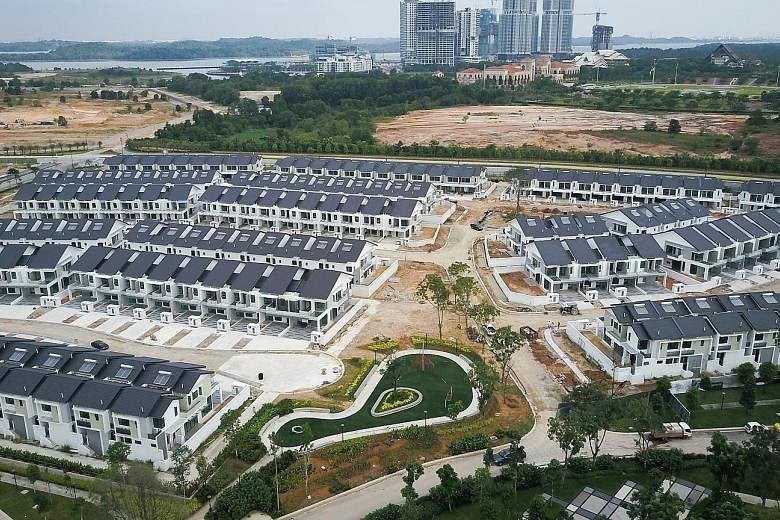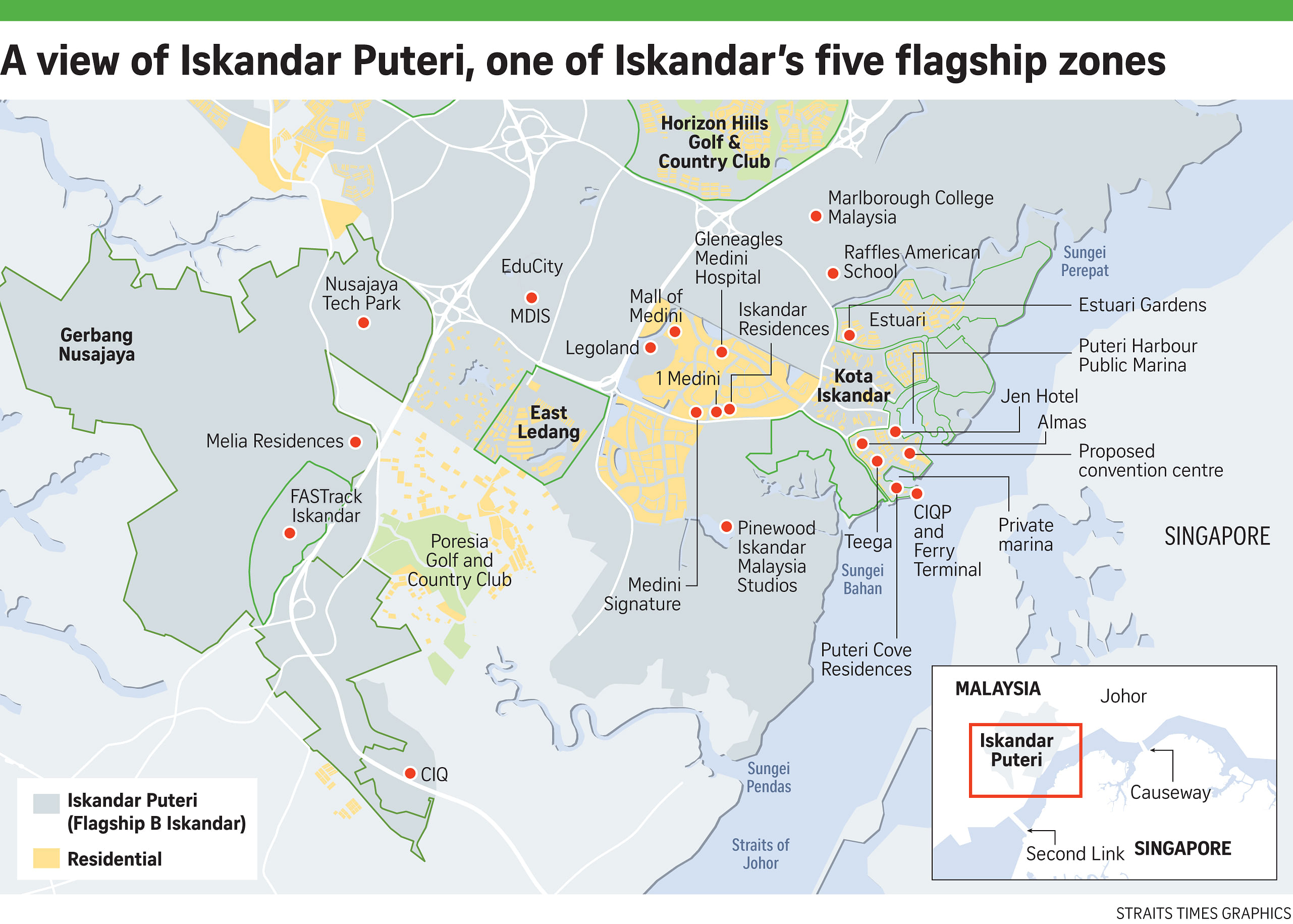The arrival in the Iskandar region of giant Chinese property players has prompted many Malaysian developers to rein in their ambitions but UEM Sunrise, one of Iskandar Malaysia's biggest land owners, welcomes the challenge.
Backed by Malaysian sovereign wealth fund Khazanah Nasional, the Malaysian developer regards the headlines and hype generated by the huge Chinese investment as a bonus, given that they have raised awareness of the ambitious Iskandar Malaysia development and given its own projects a lift.
Chief executive Anwar Syahrin Abdul Ajib told The Straits Times earlier this month: "You have to look at the positives of it, in the sense that they have put us on the map.
"Because of Forest City, people know about UEM Sunrise - I look at it from that angle," added Mr Anwar, who was referring to Chinese developer Country Garden's US$100 billion (S$138.6 billion) project.
Investments of that size have unnerved some Malaysian developers, who fear the massive projects will lead to a crippling oversupply.
UEM, as the master developer of one of the region's five flagship zones, Iskandar Puteri, formerly known as Nusajaya, could be one of those at risk but it is far from concerned. In fact, inquiries from China about its project have doubled from 2014 to now, said Mr Anwar.
He also noted the large appetites of Chinese home hunters, recounting that an investor had recently asked to buy about 250 units of UEM's 350-unit Estuari Gardens project, which was launched in 2015. Prices for the double-storey 2,709 sq ft link houses start from RM1.4 million (S$450,700).
"To the Chinese, 250 is a very small number," Mr Anwar said, but added that he did not accept the investor's request. "I didn't want the easy way out; I want to make sure that we have a good mix of international population at Estuari Gardens."
Mr Anwar has been taking a more conservative tack in selling residential properties since he took the reins of the firm in September 2014, in the light of the softer property market. While the company sold 1,300 units of Teega Residences in Puteri Harbour in just two weeks in late 2012, it now forgoes "big-bang launches" and instead sells in batches of 100 and 200 units to better manage risk, he said.
Last year, the company focused on launching affordable, mid-market developments, such as Melia Residences in Gerbang Nusajaya. It released about 100 units of Melia in three phases and has achieved take-up rates of 78 to 95 per cent.
Mr Anwar also has high hopes for the jewel in the Iskandar Puteri crown, Puteri Harbour - envisioned as Malaysia's Sentosa Cove. UEM even brought in Sentosa Cove marina operator SUTL Enterprise to develop the public and private marinas there. "It's only about 20 to 30 per cent completed. We plan to build a convention centre, more hotels and retail malls. There is a lot planned to build up this community."
Residential properties are filling up the area. UEM's Teega Residences is handing keys to unit owners, while Singapore-listed Pacific Star Development's Puteri Cove Residences will be completed this year.
But there are looming fears about the influx of thousands of units in the Iskandar Malaysia region and the impact on properties there.
Mr Anwar is optimistic about Iskandar Puteri's appeal, even as he acknowledged fears of oversupply and low occupancy rates.
He highlighted that even if areas like Danga Bay and Forest City are filled with a fraction of unit owners, "it will create some vibrancy and attract curious locals and tourists".
He was also confident of Iskandar Puteri's appeal to Singaporeans.
"There is a lot of opportunity for us to sell to Singaporeans, as the quantum is very cheap. Singapore property prices are still very high.
Things are on the upswing for the developer, despite the muted market. Its revenue almost doubled to RM541.8 million for the first quarter of this year, which it attributed mainly to sales in Johor. Net profit was RM61.3 million, more than 20 times what was recorded for the same period last year.
The rosier picture today is a contrast to that of a few years ago. Property cooling measures in Malaysia in 2014 and fears of oversupply prompted the company to defer developments. While most of its planned projects before 2014 were built, others were shelved, such as the Asian Trade Centre, a 1.4 million sq ft trade exhibition facility designed to showcase international and local manufacturers.
But the firm has gone back to the drawing board and is looking into more projects which can catalyse the development of the region.It is reviving retail plans and considering expanding the Mall of Medini into a "regional mall" five times bigger than its current size, said Mr Anwar.
The mall has about 100,000 sq ft of net lettable area, several eateries and is next to tourist attraction Legoland but sees lacklustre footfall, which it hopes to remedy.
The company also emphasised the development of Gerbang Nusajaya, the second phase of development of Iskandar Puteri in 2015.
It has high hopes for this project, given last year's announcement that it will house the station for the high-speed rail that will connect Kuala Lumpur and Singapore. The service is expected to start operating by the end of 2026.
Gerbang Nusajaya also includes the Nusajaya Tech Park, which is operational, with the first phase almost completely sold out and firms moving in. But bringing in residential investors and growing a community remain the firm's key priorities, and it is looking to do this by improving connectivity between Singapore and Malaysia. While UEM provides shuttle services to Singapore from some of its properties, it wants to make better use of the Puteri Harbour ferry terminal, which was completed in 2013 and operates services to Indonesian destinations like Karimun. Mr Anwar said one of his key challenges is starting a ferry service from Puteri Harbour to Harbourfront, originally planned for 2015. He wants to cut travel time between the two terminals from the projected 21/2 hours to about 90 minutes - an endeavour which he hopes will be completed next year.
Mr Anwar emphasised that Iskandar Puteri is still a "work in progress."
"If you look at gross development value, the estimated target GDV is more than RM30 billion, and we have invested only about RM10 billion. It's going to take another 30 years."




